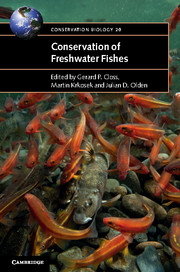Book contents
- Frontmatter
- Contents
- List of contributors
- Preface
- 1 Lost fishes, who is counting? The extent of the threat to freshwater fish biodiversity
- 2 Why are freshwater fish so threatened?
- 3 Climate change effects on freshwater fishes, conservation and management
- 4 Challenges and opportunities for fish conservation in dam-impacted waters
- 5 Chemical pollution
- 6 Multiple stressor effects on freshwater fish: a review and meta-analysis
- 7 Infectious disease and the conservation of freshwater fish
- 8 Non-indigenous fishes and their role in freshwater fish imperilment
- 9 Riparian management and the conservation of stream ecosystems and fishes
- 10 Fragmentation, connectivity and fish species persistence in freshwater ecosystems
- 11 Conservation of migratory fishes in freshwater ecosystems
- 12 Protecting apex predators
- 13 Artificial propagation of freshwater fishes: benefits and risks to recipient ecosystems from stocking, translocation and re-introduction
- 14 Freshwater conservation planning
- 15 Sustainable inland fisheries – perspectives from the recreational, commercial and subsistence sectors from around the globe
- 16 Understanding and conserving genetic diversity in a world dominated by alien introductions and native transfers: the case study of primary and peripheral freshwater fishes in southern Europe
- 17 Maintaining taxonomic skills; the decline of taxonomy – a threat to fish conservation
- 18 Synthesis – what is the future of freshwater fishes?
- Index
- References
15 - Sustainable inland fisheries – perspectives from the recreational, commercial and subsistence sectors from around the globe
Published online by Cambridge University Press: 05 December 2015
- Frontmatter
- Contents
- List of contributors
- Preface
- 1 Lost fishes, who is counting? The extent of the threat to freshwater fish biodiversity
- 2 Why are freshwater fish so threatened?
- 3 Climate change effects on freshwater fishes, conservation and management
- 4 Challenges and opportunities for fish conservation in dam-impacted waters
- 5 Chemical pollution
- 6 Multiple stressor effects on freshwater fish: a review and meta-analysis
- 7 Infectious disease and the conservation of freshwater fish
- 8 Non-indigenous fishes and their role in freshwater fish imperilment
- 9 Riparian management and the conservation of stream ecosystems and fishes
- 10 Fragmentation, connectivity and fish species persistence in freshwater ecosystems
- 11 Conservation of migratory fishes in freshwater ecosystems
- 12 Protecting apex predators
- 13 Artificial propagation of freshwater fishes: benefits and risks to recipient ecosystems from stocking, translocation and re-introduction
- 14 Freshwater conservation planning
- 15 Sustainable inland fisheries – perspectives from the recreational, commercial and subsistence sectors from around the globe
- 16 Understanding and conserving genetic diversity in a world dominated by alien introductions and native transfers: the case study of primary and peripheral freshwater fishes in southern Europe
- 17 Maintaining taxonomic skills; the decline of taxonomy – a threat to fish conservation
- 18 Synthesis – what is the future of freshwater fishes?
- Index
- References
Summary
INTRODUCTION
Globally, freshwater ecosystems provide varied fishing opportunities (herein termed inland fisheries) represented by three sectors: recreational, commercial and subsistence fisheries. From the depths of the Laurentian Great Lakes to the shallow floodplains of the Ganges River, and from under-ice fisheries in Scandinavia to the rice fields of Southeast Asia, fish and other aquatic life are omnipresent components of fluvial and lacustrine systems. Freshwater fishes generate many ecosystem services that extend beyond their use in fisheries (Holmlund & Hammer, 1999; Cowx & Portocarrereo, 2011). Given the diversity of freshwater fish assemblages, levels of fisheries productivity, cultural norms, density of human population and socioeconomic conditions, it is not surprising that there is immense variation in how, why and the extent to which freshwater fishes and other aquatic animals are exploited. Whether it be sustaining livelihoods through the provision of essential nutrients, generating income, or enabling leisure time with family, inland fisheries are important. Although there are accepted definitions for the three fishing sectors (i.e. UN FAO – see below), ambiguities and exceptions remain that complicate appraisal and management.
Compared with marine waters where industrial-scale commercial fisheries predominate, inland fisheries tend to be smaller in scale and catches generally do not enter the global marketplace. Moreover, whereas exploitation pressures are the primary threat facing marine fish populations and marine ecosystems, in inland systems there are multiple threats including many unrelated to fishing (Arlinghaus et al., 2002). Indeed, declines in freshwater fish fauna are implicated with broad-scale economic activities such as flow regulation, hydropower, agriculture, urbanisation and pollution (Limburg et al., 2011; Chapters 4 and 9). Reflecting the multiple threats, freshwater fishes are among the most imperilled taxa on the globe (Strayer & Dudgeon, 2010; Chapter 2), freshwater biodiversity is in crisis (Dudgeon et al., 2006) and freshwater ecosystems are among the most altered (Kennish, 2002; Malmqvist & Rundle, 2002). Despite the many threats to inland fishes and fisheries, they receive disproportionally less interest and attention from the global conservation community and international political spheres. Indeed, global capture statistics underrepresented inland fisheries and their contribution to global production (Welcomme et al., 2010; Welcomme, 2011a,b), partly because of the diffuse nature of inland fisheries (Beard et al., 2011). By contrast, it is comparatively easy to generate data for commercial fisheries where products sold on established domestic and export markets can be readily monitored.
- Type
- Chapter
- Information
- Conservation of Freshwater Fishes , pp. 467 - 505Publisher: Cambridge University PressPrint publication year: 2015
References
- 6
- Cited by



